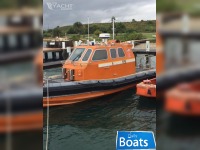Rescue vessels

What are rescue vessels?
Introduction
What are rescue vessels? Rescue vessels are specially designed ships or boats that are used to rescue people who are in danger at sea. There are different types of rescue vessels, each with its own specific function. The history of rescue vessels dates back to the early days of maritime travel, when these ships were first used to save people from shipwrecks. Today, modern rescue vessels play a vital role in saving lives and protecting property at sea. With new technologies and an increasing demand for their services, rescue vessels will continue to play a vital role in the future of maritime travel.
What are rescue vessels
Types of rescue vessels
Rescue vessels come in many different shapes and sizes, from small boats to large ships. They may be designed for specific types of emergencies, such as search and rescue, firefighting, or medical evacuation. Some rescue vessels are equipped with cranes or other lifting devices to retrieve people from the water or from heights.
Functions of rescue vessels
Rescue vessels are used to transport people in distress to safety. They may also be used to provide medical care, supplies, and other assistance during emergencies. Rescue vessels may be operated by government agencies, private companies, or volunteer organizations.

History of rescue vessels
Early rescue vessels
Rescue vessels have been used since ancient times to assist ships in distress and to save lives. One of the earliest recorded examples is from the 4th century BC, when the Greek city of Syracuse sent out a ship to rescue survivors of a shipwreck.
In medieval times, religious orders such as the Knights Hospitaller and Knights Templar operated hospitals and ambulances, sometimes using boats, to transport patients and provide medical care. During the Crusades, these orders also operated ships which were used to rescue pilgrims stranded in hostile territory.
Modern rescue vessels
The modern era of rescue vessels began in the 19th century with the development of steam-powered ships. These new ships allowed for quicker and more reliable rescues, as they were not reliant on wind or currents. The first steam-powered rescue vessel was the RNLI's 'Royal National Lifeboat Institution' lifeboat, which was introduced in 1821.
The 20th century saw further advances in maritime safety, with the introduction of radio communications and radar. This allowed for quicker response times to distress calls and improved coordination of rescue efforts. In addition, new technologies such as sonar and satellite tracking have made it easier to locate lost or missing vessels.
The 21st century has continued to see advances in maritime safety, with the development of new technologies such as drones and autonomous vehicles. There has also been an increased focus on environmental protection, with many rescue organizations now working to protect marine wildlife as well as humans.
The future of rescue vessels
New technologies
One trend that is likely to continue in the future is the use of new technologies on rescue vessels. For example, the use of drones and robots is becoming increasingly common for tasks such as search and rescue operations. In addition, new materials and construction methods are being used to build more durable and efficient vessels.
Increasing demand
Another trend that is likely to continue is the increasing demand for rescue vessels. This is due to factors such as population growth, climate change, and the increasing number of people who live near bodies of water. As a result, we can expect to see more rescue vessels being built in the future.
Conclusion
Rescue vessels are boats or ships that are specially designed and equipped to rescue people from dangerous or life-threatening situations at sea. There are many different types of rescue vessels, each with its own unique capabilities and functions. Rescue vessels have a long history dating back to the early days of maritime travel, and their importance has only grown in recent years as the number of people taking to the seas has increased. In the future, rescue vessels will become even more advanced as new technologies are developed and the demand for them increases.







